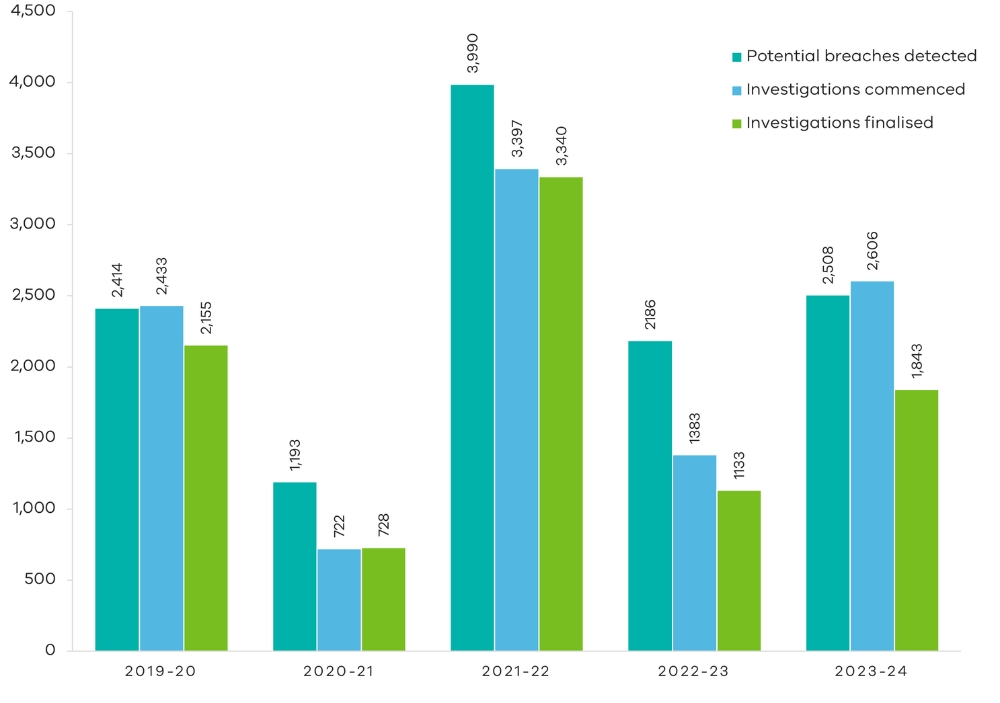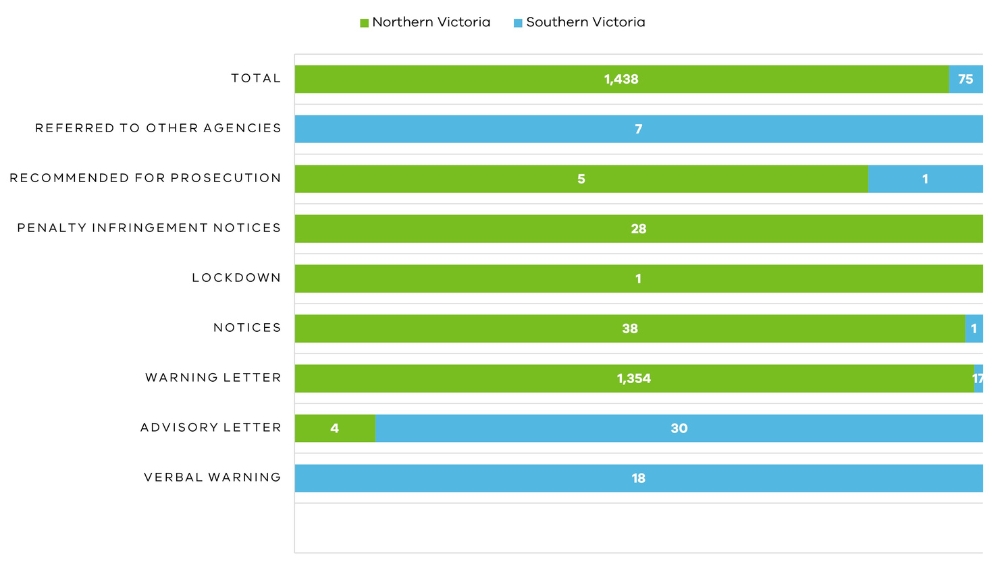On this page:
This is Victoria’s 10th consecutive annual non-urban water compliance report.
Victoria has a zero-tolerance approach to the unauthorised take of water and is committed to maintaining a strong compliance record to maintain the integrity of water entitlements and protect the environment. This ensures a level playing field for all water users.
Water corporations continue to play a key role in securing the rights of all water users as well as safeguarding the State’s water resources. They work directly with water users as the first step in supporting compliance.
This report details Victoria’s compliance and enforcement activities for the 2023-24 reporting period.
A breakdown of compliance activities between 1 July 2023 to 30 June 2024
- In 2023-24, there were 2,508 alleged breaches under the Water Act 1989 that were detected by water corporations. A total number of 2,606 detected breaches were investigated which included breaches carried forward from the previous year. 1,843 investigations were finalised. Unauthorised take of water remains the dominant breach detected by Water Corporations.
- Total number of 1,504 enforcement actions were taken during 2023-24 including 18 verbal warnings, 1,405 advisory and warning letters (including second warning letters), 38 notices, 28 penalty infringement notices issued, 1 restrict supply of water (section 141 of the Water Act 1989) and 6 matters were recommended for prosecution by water corporations.
Compliance activities and enforcement action statistics 2023-24
Water corporations continue to meet their obligations by reporting annually on their compliance and enforcement activities as per clause 7.3A of the Water Industry Act 1994 – Statement of Obligations:
- Water Industry Act 1994 - Statement of obligations (PDF, 5.4 MB)
- Water Industry Act 1994 - Statement of obligations - accessible (DOCX, 70.4 KB)
The following state-wide statistics have been compiled for the 2023-24 reporting period.
Compliance activities
Non-urban metering remains an important tool used for accurate and comprehensive compliance reporting.
As of 30 June 2024, there are 51,117 meters and 60% of the meters are fitted with telemetry in Victoria, which enables real-time monitoring of high-volume water users and sends data electronically to water corporations.
During 2023-24, the total number of state-wide meter reads was 80,832 by water corporations’ staff. These meter reads relate to meter maintenance and compliance. For more information see 2023-24 Non-urban metering implementation annual report.
Number of detected potential breaches and investigations since 2019-2020
Water corporations reported that they detected 2,508 potential breaches of the Water Act 1989 during 2023-24. Unauthorised take of water remains the dominant category of potential breaches detected.
Water corporations commenced 2,606 investigations and finalised 1,843 investigations (including breaches that were carried forward from the previous year).
Number of potential breaches and investigations since 2019-2020

Number of detected potential breaches by area
There are higher numbers of potential breaches detected in the northern region of Victoria, which is commensurate with the higher number of water users and licence holders within that region and more active water markets.
| Potential breaches detected | Investigations commenced | Investigations finalised |
|---|---|---|---|
Northern Victoria | 2212 | 2223 | 1500 |
Southern Victoria | 296 | 383 | 343 |
Total | 2508 | 2606 | 1843 |
Note: Of the 2,606 investigations that were commenced, some of those breaches were carried forward from the previous year.
Summary of detected potential breaches by offence
Enforcement actions
There are a number of enforcement tools available for Victorian water corporations to enforce compliance under the Water Act 1989:
- verbal warnings
- advisory letters
- formal warning letters
- notice
- reduce, restrict or discontinue of water supply
- issue a penalty infringement notice (fine)
- prosecution.
Verbal warnings and advisory letters are the first enforcement actions taken in response to a breach, followed by a warning letter, notice, reduce restrict or discontinue of water supply, penalty infringement notice (fine) or prosecution.
Water corporations may take more than one enforcement action if the water user does not rectify the breach after using one of the enforcement actions.
Between 1 July 2023 to 30 June 2024, water corporations took 1,504 enforcement actions against breaches detected under the Water Act 1989.
The main enforcement actions taken against water users who breached the Water Act 1989 were issued with a warning letter, an advisory letter or notice. Most water users are taking immediate action to remedy the issue after receiving either a warning letter, advisory letter or a notice.
Summary of enforcement actions taken between 1 July 2019 to 20 June 2024
Enforcement actions taken in Northern Victoria and Southern Victoria from 1 July 2023 and 30 June 2024

Verbal warnings
Issuing a verbal warning is one of the first level enforcement actions taken by water corporations against a breach detected. Most water users will remedy an issue after receiving a verbal warning. Between 1 July 2023 and 30 June 2024, water corporations issued 18 verbal warnings for breaches of the Water Act 1989.
Advisory letters
An advisory letter is typically the first level enforcement action taken by water corporations when a breach has occurred. Not all water corporations issue advisory letters. Between 1 July 2023 and 30 June 2024, water corporations issued 46 advisory letters for breaches of the Water Act 1989.
Warning letters
Warning letters may be the first response for some water corporations, instead of issuing an advisory letter. Between 1 July 2023 and 30 June 2024, water corporations issued 1,367 warning letters for breaches of the Water Act 1989.
Notices
Water corporations may, by notice in writing, to a person who contravenes the Water Act 1989, regulations or recreational by-laws, issue a notice requiring that person (or body corporate) to take action to remedy the contravention. Between 1 July 2023 and 30 June 2024, water corporations issued 39 notices for breaches of the Water Act 1989.
Authority may reduce, restrict or discontinue water supply
Water corporations have the power to lock down outlets in the event of more serious breaches of the Water Act 1989.
A water corporation may reduce or restrict the quantity of water supplied to any person, or discontinue the supply of water, under section 141 of the Water Act 1989 to prevent continuing water theft. Between 1 July 2023 and 30 June 2024, there was only 1 lockdown of water supply.
Penalty Infringement Notice (Fines)
Penalty infringement notices (PINs) are issued to penalise and deter water users from contravening the Water Act 1989. From 1 July 2024, the maximum fine is $2,371 for individuals and $11,855 for body corporates.
Between 1 July 2023 to 30 June 2024, a total of 28 PINs were issued in Victoria. 27 of the infringement notices were issued for unauthorised take of water (section 33E of the Water Act 1989), and one was issued for wrongful take of water (section 289 of the Water Act 1989).
The maximum financial penalty issued for 2023-24 was $5,769 (body corporate), the minimum was $192 (individual), with a median of $577 and average of $1,078.25.
PINs and Volume of detected unauthorised take
Prosecutions
There were 9 prosecutions that finalised between 1 July 2023 to 30 June 2024, including 4 cases that were carried over from the previous year.
Summary of prosecutions between 1 July 2023 to 30 June 2024
Prosecutions finalised between 1 July 2023 and 30 June 2024
The below table provides details of the prosecutions matters that were before the Court and had been finalised between 1 July 2023 to 30 June 2024.
Prosecutions carried forward into the 2024-2025 financial year
Priorities for 2024-25
The Department of Energy, Environment and Climate Action, together with the water corporations are committed to ensuring Victoria has a strong and robust compliance and enforcement system, with checks and balances in place, to maintain and build confidence in the market. In 2024-2025, we have 4 priority areas and 3 ongoing priorities.
Priorities areas for 2024-25
- Embedding a compliance risk based planning and proactive monitoring approach into regulatory regime.
- Building regulatory capability of staff by providing compliance training and operational procedures for safe, efficient, and consistent work practices.
- Implementing the Water (Infringement) Regulations 2020 and the Water and Catchment Legislation Amendment Act 2021 changes.
- Establishing a consistent approach to monitoring small catchment dams with licensing and construction obligations.
Ongoing priorities
- Implementing a zero-tolerance approach to addressing unauthorised take.
- Regularly and consistently engaging and communicating with water users and the public about water compliance.
- Delivering on metering action plans and the Non-urban Water Metering Policy including applying telemetry cost benefit analysis where required.
Page last updated: 09/01/25
